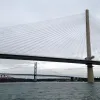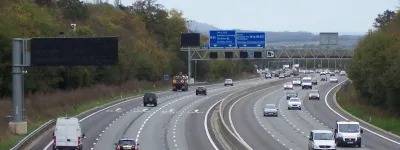At the very end of August 2017, the new M90 Queensferry Crossing opened to traffic, marking the completion of a new bridge across the Firth of Forth between Edinburgh and Fife.
Great ceremonies were held and the event received blanket coverage in the press and on TV news, and it was also marked with some considerable excitement here on Roads.org.uk.
If you want to see the new bridge, or indeed the three very different and striking bridges side by side, you can look up pictures on the internet very easily, and even find videos shot from vehicles crossing them.
But one of the best views to be had - and one of the least seen - is from the Forth itself. If you can find a way to get yourself on the water, the true scale and majesty of all three bridges becomes apparent. That's just what we did to create this gallery of pictures. Taking a small detour into the world of rail infrastructure, we explore the Forth Rail Bridge, Forth Road Bridge and Queensferry Crossing from below.
From land, three enormous bridges make quite an impact on the skyline. The Forth Rail Bridge is the most obvious, but the towers of the Forth Road Bridge and the Queensferry Crossing are visible too.
We'll tour the bridges in order of age, so we should start with the Forth Rail Bridge - officially, just the "Forth Bridge" - which carries the railway north from Edinburgh and was completed in 1890. It took eight years to build. At its peak, 4,500 men worked to build it.
It's one of the best-known bridges in the world, of course, but familiarity with its outline can be deceptive. It's only up close that you realise just how colossal it is. In this close-up, the deck - carrying two railway tracks - passes through the narrow tapering end of one of the cantilevers.
The northern cantilever, with North Queensferry behind it, demonstrates the unbelievable proportions of the structure. The two-track railway is almost lost somewhere amid the steelwork.
The Forth Bridge was alone for 74 years, but now has two travelling companions over the river. 800m to its west is the Forth Road Bridge, and beyond that, the new Queensferry Crossing.
The Forth Road Bridge is remarkably light and simple by comparison, with open towers supporting a lightweight road deck. Suspension bridges were ruled out for the railway crossing because they are by nature flexible structures, but it's a perfectly sound design for a road.
The road deck, seen from below, is hardly a deck at all - it's an open framework of struts and girders supporting four separate decks for traffic and pedestrians. This design makes it lightweight and also reduces the effect of strong winds - though only to the extent that high winds have never damaged the bridge. Throughout its life, the Forth Road Bridge has suffered frequent and problematic closures because of the wind.
Down below, the two towers are surprisingly insubstantial, considering the enormous weight they carry, rising from caissons sunk into the river bed. Daylight can be seen through the bridge deck.
The southern end of the bridge, seen from the west, with South Queensferry behind it, shows the size of the bridge well. Its simple form and lightweight structure are worlds away from the Forth Rail Bridge.
These views of the Forth Road Bridge have so far shown it in splendid isolation. In reality, as the middle one of the three, it's hard to get a view of it that doesn't involve one of the others. Less than 500m to the west is the new Queensferry Crossing.
This latest bridge, opened in 2017, is a different design again: a cable-stayed bridge, with three remarkably slender, unadorned towers rising from the water. Unlike the other bridges, whose towers effectively stand on small artificial islands, the Queensferry Crossing simply rises from the water.
Modern bridge design has new ways of dealing with the wind. The bridge deck is totally enclosed and looks reassuringly solid, and the joins between the pre-fabricated sections that were towed into the river and hoisted into place can now barely be seen. Tall barriers shield traffic from the wind.
The scale of this bridge is easy to miss, partly because it's so simple and clean in appearance. The deck, supported by narrow concrete piers, is wide enough to carry two lanes of traffic plus full hard shoulders.
A better idea of scale is given by the overhead signs suspended from the towers - each is a full-size sign gantry with electronic message signs, the sort of thing that can alter the skyline for miles when installed on a rural motorway. Here they are mere details.
From the west, looking back at all three bridges, it's an undeniably impressive and unique view. Three bridges representing the best engineering practice of three centuries, all solving the same problem: how to safely cross such a vast and difficult body of water as the Firth of Forth.
This and the following pictures were taken during a public walk across the Queensferry Crossing on 3 September, just before it opened to traffic, and provide a rare chance to see it up close.
From the road deck the supporting cables, anchored into the central reservation, are truly enormous.
The towers are no less impressive, and the height and mass of them is striking. From a vehicle it's rarely possible to look upwards at this point.
The wind barriers are semi-transparent and offer a slightly distorted view of the Forth Bridge a little further east.
Picture credits
- The final five pictures are published here courtesy of Crinan Dunbar.
With thanks to Elena Wolfson for additional photography.




















